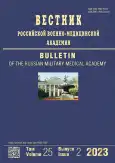Computer planimetry as an objective control method for wound healing in diabetic foot syndrome
- Authors: Ivanusa S.Y.1, Risman B.V.1, Shayakhmetov R.E.1, Yanishevskiy A.V.1, Babenko M.V.1, Shipilov P.A.1
-
Affiliations:
- Kirov Military Medical Academy
- Issue: Vol 25, No 2 (2023)
- Pages: 239-248
- Section: Original Study Article
- URL: https://journals.rcsi.science/1682-7392/article/view/134104
- DOI: https://doi.org/10.17816/brmma321607
- ID: 134104
Cite item
Abstract
The study evaluated the results of treating patients with infectious complications of diabetic foot syndrome using minimally invasive endovideosurgical methods of computer planimetry with the Russian program “AnaliRan” in conjunction with traditional and endovideoscopic methods. The technique employed significantly reduced the treatment duration for this patient population. The technique employed significantly reduced the treatment duration for this patient population. This study provided valuable insights into the most effective ways of assessing the dynamics of the wound process. Despite the patient’s comorbidity, the assessment of laboratory parameters was deemed insignificant, as timely correction of the treatment of the wound process occurred against the background of modern objective methods for assessing its dynamics. Overall, the use of computer planimetry with the Russian program “AnaliRan” as a technique for analyzing wound process indicators in infectious complications of diabetic foot syndrome provided objective assessment of the relative area of granulation, necrosis, fibrin, and epithelium, enabling the evaluation of treatment effectiveness. For treating open wounds with infectious complications of diabetic foot syndrome, the program “AnaliRan” along with clinical data can determine the stage of the wound process, indications for surgical treatments, the use of negative pressure therapy, and the application of modern wound coatings. Analyzing the endovideoscopic frames with the program AnaliRan allows an objective assessment of the wound process in the cavity, based on numerical indicators and the clinical picture, facilitating the formation of indications for staged videoscopic treatments using ultrasonic cavitation, the change of local medicines, and the removal of drains. The data obtained during planimetry of wounds and wound cavities indicate the effectiveness and prospects of the technique. Consequently, the choice of tactics for managing purulent wounds, as well as methods for assessing the course of the wound process, remains an extremely topical issue in the modern world. Further accumulation of material will probably allow the development of specific recommendations for the use of various treatment methods based on digital information.
Full Text
##article.viewOnOriginalSite##About the authors
Sergei Yа. Ivanusa
Kirov Military Medical Academy
Email: rauan198944@gmail.com
ORCID iD: 0000-0003-3948-6928
SPIN-code: 8752-1600
MD, Dr. Sci. (Med.), professor
Russian Federation, Saint PetersburgBoris V. Risman
Kirov Military Medical Academy
Email: rauan198944@gmail.com
ORCID iD: 0000-0002-6634-4450
SPIN-code: 8022-6313
MD, Dr. Sci. (Med.)
Russian Federation, Saint PetersburgRauan E. Shayakhmetov
Kirov Military Medical Academy
Email: rauan198944@gmail.com
ORCID iD: 0000-0002-4459-4790
SPIN-code: 9334-1613
adjunct
Russian Federation, Saint PetersburgAndrey V. Yanishevskiy
Kirov Military Medical Academy
Email: rauan198944@gmail.com
SPIN-code: 4801-0861
MD, Cand. Sci. (Med.)
Russian Federation, Saint PetersburgMaria V. Babenko
Kirov Military Medical Academy
Email: rauan198944@gmail.com
ORCID iD: 0009-0000-1128-1096
SPIN-code: 4150-0610
MD, Cand. Sci. (Med.)
Russian Federation, Saint PetersburgPavel A. Shipilov
Kirov Military Medical Academy
Author for correspondence.
Email: rauan198944@gmail.com
ORCID iD: 0009-0007-7497-6443
SPIN-code: 6614-7866
cadet
Russian Federation, Saint PetersburgReferences
- Глобальный доклад по диабету // Всемирная организация здравоохранения. Женева, 2018. 84 с.
- Галстян Г.Р., Викулова О.К., Исаков М.А., и др. Эпидемиология синдрома диабетической стопы и ампутаций нижних конечностей в Российской Федерации по данным Федерального регистра больных сахарным диабетом (2013–2016 гг.) // Сахарный диабет. 2018. Т. 21, № 3. С. 170–177. doi: 10.14341/DM9688
- O'Connor S., Blais C., Leclerc J., et al. evolution in trends of primary lower-extremity amputations Associated with diabetes or peripheral artery disease from 2006 to 2019 // Can J Cardiol. 2023. Vol. 39, No. 3. Р. 331–330. doi: 10.1016/j.cjca.2022.11.010
- Loredo R.A., Garcia G., Chhaya S. Medical imaging of the diabetic foot // Clin Podiatr Med Surg. 2007. Vol. 24, No. 3. Р. 397–424. doi: 10.1016/j.cpm.2007.03.010
- Дедов И.И., Шестакова М.В., Майоров А.Ю., и др. Алгоритмы специализированной медицинской помощи больным сахарным диабетом. 9-й выпуск // Сахарный диабет. 2019. Т. 22, № S1-1. С. 1–144. doi: 10.14341/DM20191S1
- Нездолий Я.А. Клинико-морфологическая оценка эффективности лечения трофических язв на фоне синдрома диабетической стопы // Известия Российской военно-медицинской академии. 2019. Т. 38, № S1-2. С. 29–31.
- Янишевский А.В. Эндовидеоскопический метод лечения гнойно-некротических осложнений синдрома диабетической стопы // Материалы итоговой конференции военно-научного общества слушателей факультета руководящего медицинского состава. Санкт-Петербург: ВМА, 2017. С. 429–431.
- Рисман Б.В. Лечение гнойно-некротических осложнений синдрома диабетической стопы: дис. … д-ра мед. наук. Санкт-Петербург, 2011. 219 с.
- Falangan M. Wound measurement: can it help us to monitor progression to healing // J Wound Care. 2003. Vol. 12, No. 5. P. 189–194. doi: 10.12968/jowc.2003.12.5.26493
- Свидетельство о государственной регистрации программы для ЭВМ № 2022660216 РФ. АналиРан: № 2022619603, заяв. 23.05.2022/ 01.06.2022. Иванов Г.Г., Балашов И.А .
- Hammer Ø., Harper D.A.T., Ryan P.D. PAST: Paleontological statistics software package for education and data analysis // Palaeontol Electron. 2001. Vol. 4, No. 1. Р. 1–9.
Supplementary files

















